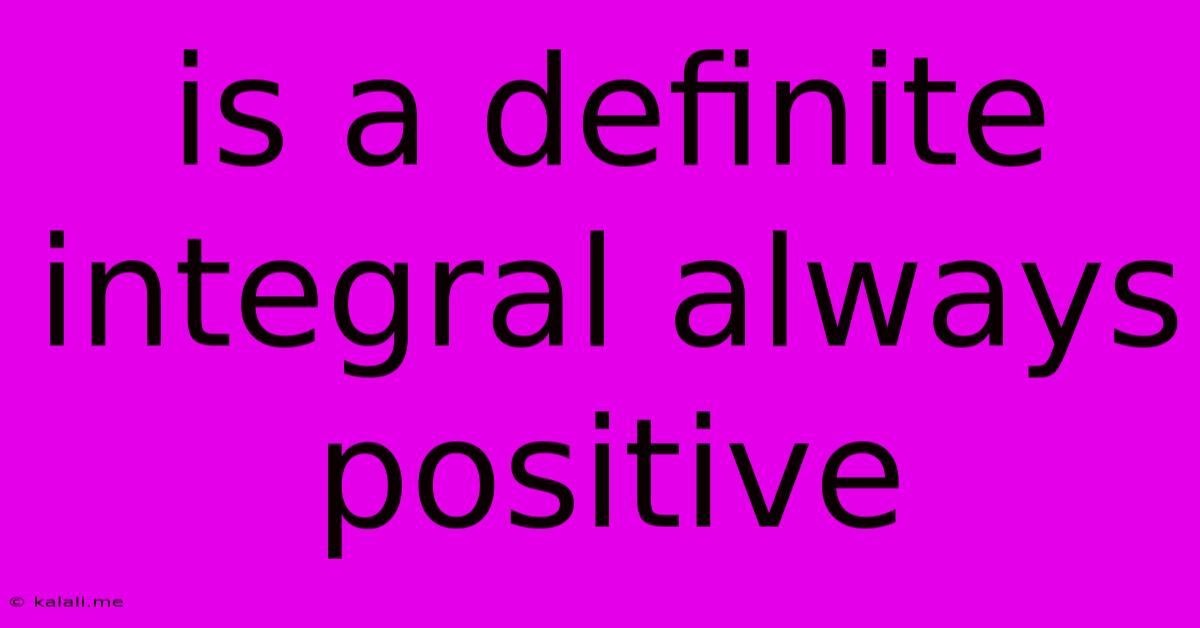Is A Definite Integral Always Positive
Kalali
Jun 03, 2025 · 3 min read

Table of Contents
Is a Definite Integral Always Positive? A Deep Dive into the Concept
Meta Description: Understanding definite integrals is crucial in calculus. This article explores the common misconception that definite integrals always yield positive results, explaining when they are positive, negative, or zero, and why. We'll delve into the geometric interpretation and provide illustrative examples.
A common question among students learning calculus is whether a definite integral always results in a positive value. The short answer is: no, a definite integral is not always positive. While the area under a curve is often visualized as positive, the definite integral represents a signed area, incorporating both positive and negative contributions.
This article will clarify this misconception by exploring the geometric interpretation of definite integrals and examining scenarios where the integral can be positive, negative, or zero.
Understanding the Geometric Interpretation
The definite integral ∫<sub>a</sub><sup>b</sup> f(x) dx represents the signed area between the curve y = f(x) and the x-axis, from x = a to x = b. "Signed" is the key here.
-
Positive Area: If the function f(x) is above the x-axis (i.e., f(x) > 0) on the interval [a, b], the integral represents the area above the x-axis and is positive.
-
Negative Area: If f(x) is below the x-axis (i.e., f(x) < 0) on the interval [a, b], the integral represents the area below the x-axis and is negative. This is a crucial distinction. The area itself is positive, but the signed area represented by the integral is negative.
-
Zero Area: If the positive and negative areas cancel each other out, the definite integral will be zero. This occurs when the areas above and below the x-axis are equal in magnitude.
Examples to Illustrate the Concept
Let's examine a few examples to solidify our understanding:
Example 1: Positive Definite Integral
Consider the integral ∫<sub>0</sub><sup>1</sup> x dx. The function f(x) = x is always positive on the interval [0, 1]. The integral evaluates to ½, representing the positive area of a triangle with base 1 and height 1.
Example 2: Negative Definite Integral
Consider the integral ∫<sub>-1</sub><sup>0</sup> x dx. The function f(x) = x is always negative on the interval [-1, 0]. The integral evaluates to -½, representing the negative signed area of a triangle below the x-axis.
Example 3: Zero Definite Integral
Consider the integral ∫<sub>-1</sub><sup>1</sup> x dx. Here, the function is positive on [0, 1] and negative on [-1, 0]. The positive and negative areas are equal in magnitude, resulting in a definite integral of 0.
Beyond Simple Functions: Complex Scenarios
The principle remains the same for more complex functions. The integral accumulates the signed areas. For instance, a function that oscillates above and below the x-axis will have a definite integral that reflects the net signed area – the sum of the positive and negative areas. The integral could be positive, negative, or zero depending on the balance between positive and negative contributions.
Conclusion: The Significance of "Signed Area"
The concept of a signed area is fundamental to understanding definite integrals. While intuition might suggest a positive result, the mathematical definition explicitly incorporates the sign of the function's value, leading to positive, negative, or zero results depending on the function and the integration limits. Understanding this nuance is crucial for accurate application of definite integrals in various fields like physics, engineering, and economics.
Latest Posts
Latest Posts
-
Change Light Kit On Ceiling Fan
Jun 05, 2025
-
Hwy Is Spherical Use Rho Instead Of R
Jun 05, 2025
-
How To Restaart Game Of Gmod
Jun 05, 2025
-
How Long Does It Take To Bench 225
Jun 05, 2025
-
Can Older Rpi Camera Work In Pi 5
Jun 05, 2025
Related Post
Thank you for visiting our website which covers about Is A Definite Integral Always Positive . We hope the information provided has been useful to you. Feel free to contact us if you have any questions or need further assistance. See you next time and don't miss to bookmark.